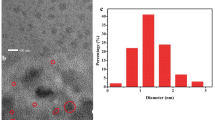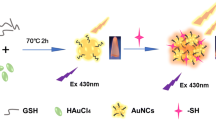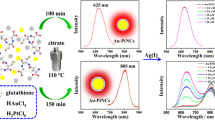Abstract
When thiolactic acid–capped gold nanoclusters (AuNCs@TLA) with strong near-infrared (NIR, 800 nm) emission were applied to detect metal ions, only Ag+ induced the generation of two new emission peaks at 610 and 670 nm in sequence and quenching the original NIR emission. The new peak at 670 nm generated after the 800-nm emission disappeared utterly. The ratiometric and turn-on responses showed different linear concentration ranges (0.10–4.0 μmol·L−1 and 10–50 μmol·L−1) toward Ag+, and the limit of detection (LOD) was 40 nmol·L−1. Especially, the probe exhibited extremely high selectivity and strong anti-interference from other metal ions. Mechanism studies showed that the novel responses were attributed to the anti-galvanic reaction of AuNCs to Ag+ and formation of bimetallic nanoclusters. The two new emission peaks were due to the composition change and size growth of the metal core. Besides, bovine serum albumin (BSA) has been employed as a signal amplifier based on the assembly-induced emission enhancement properties of AuNCs, which improved the LOD to 10 nmol·L−1. Moreover, the ratiometric method is feasible for Ag+ detection in diluted serum with high recovery rates, showing large application potential in the biological system. The present study supplies a novel ratiometric probe for Ag+ with a two-stage response and provides a novel signal amplifier of BSA, which will facilitate and promote the application of NIR-emitted metal nanoclusters in biological system.
Graphical Abstract






Similar content being viewed by others
Data Availability
All data generated or analysed during this study are included in this published article and its supplementary information files.
References
Lalley J, Dionysiou DD, Varma RS, Shankara S, Yang DJ, Nadagouda MN (2014) Silver-based antibacterial surfaces for drinking water disinfection - an overview. Curr Opin Chem Eng 3:25–29
Dai F, Xie M, Wang Y, Zhang L, Zhang Z, Lu X (2022) Synergistic effect improves the response of active sites to target variations for picomolar detection of silver ions. Anal Chem 94:10462–10469
Rasheed T, Bilal M, Nabeel F, Iqbal HMN, Li C, Zhou Y (2018) Fluorescent sensor based models for the detection of environmentally-related toxic heavy metals. Sci Total Environ 615:476–485
Liu T, Fu L, Yin C, Wu M, Chen L, Niu N (2022) Design of smartphone platform by ratiometric fluorescent for visual detection of silver ions. Microchem J 174:107016
Choi S, Lee G, Park IS, Son M, Kim W, Lee H, Lee SY, Na S, Yoon DS, Bashir R, Park J, Lee SW (2016) Detection of silver ions using dielectrophoretic tweezers-based force spectroscopy. Anal Chem 88:10867–10875
Gao Z, Liu GG, Ye H, Rauschendorfer R, Tang D, Xia X (2017) Facile colorimetric detection of silver ions with picomolar sensitivity. Anal Chem 89:3622–3629
Wang YW, Wang M, Wang L, Xu H, Tang S, Yang HH, Zhang L, Song HA (2017) Simple assay for ultrasensitive colorimetric detection of Ag+ at picomolar levels using platinum nanoparticles. Sensors 17:2521
Benton EN, Marpu SB, Omary MA (2019) Ratiometric phosphorescent silver sensor: detection and quantification of free silver ions within silver nanoparticles. ACS Appl Mater Interfaces 11:15038–15043
Song Y, Wang X, Liu H, Wang X, Li D, Zhu HL, Qian Y (2022) A high selective colorimetric fluorescent probe for detection of silver ions in vitro and in vivo and its application on test strips. Talanta 246:123366
Chun KY, Oh Y, Rho J, Ahn JH, Kim YJ, Choi HR, Baik S (2010) Highly conductive, printable and stretchable composite films of carbon nanotubes and silver. Nat Nanotechnol 5:853–857
Musil S, Kratzer J, Vobecký M, Benada O, Matoušek T (2010) Silver chemical vapor generation for atomic absorption spectrometry: minimization of transport losses, interferences and application to water analysis. J Anal At Spectrom 25:1618–1626
Hanley TA, Saadawi R, Zhang P, Caruso JA, Landero-Figueroa J (2014) Separation of silver ions and starch modified silver nanoparticles using high performance liquid chromatography with ultraviolet and inductively coupled mass spectrometric detection. Spectrochim Acta B 100:173–179
Krachler M, Mohl C, Emons H, Shotyk W (2002) Analytical procedures for the determination of selected trace elements in peat and plant samples by inductively coupled plasma mass spectrometry. Spectrochim Acta B 57:1277–1289
Săcărescu L, Chibac-Scutaru AL, Roman G, Săcărescu G, Simionescu M (2023) Selective detection of metal ions, sulfites and glutathione with fluorescent pyrazolines: a review. Environ Chem Lett 21:561–596
Hu T, Lai Q, Fan W, Zhang Y, Liu Z (2023) Advances in portable heavy metal ion sensors. Sensors 23:4125
Kang X, Zhu M (2019) Tailoring the photoluminescence of atomically precise nanoclusters. Chem Soc Rev 48:2422–2457
Chakraborty I, Pradeep T (2017) Atomically precise clusters of noble metals: emerging link between atoms and nanoparticles. Chem Rev 117:8208–8271
Song X, Zhu W, Ge X, Li R, Li S, Chen X, Song J, Xie J, Chen X, Yang H (2021) A new class of NIR-II gold nanocluster-based protein biolabels for in vivo tumor-targeted imaging. Angew Chem Int Edit 60:1306–1312
Xiao Y, Wu Z, Yao Q, Xie J (2021) Luminescent metal nanoclusters: biosensing strategies and bioimaging applications. Aggregate 2:114–132
Yamazaki S, Oh E, Susumu K, Medintz IL, Scott AM (2021) Excited-state dynamics of photoluminescent gold nanoclusters and their assemblies with quantum dot donors. J Phys Chem C 125:12073–12085
Kim J, Piao Y, Hyeon T (2009) Multifunctional nanostructured materials for multimodal imaging, and simultaneous imaging and therapy. Chem Soc Rev 38:372–390
Crawford SE, Hartmann MJ, Millstone JE (2019) Surface chemistry-mediated near-infrared emission of small coinage metal nanoparticles. Acc Chem Res 52:695–703
He K, Zhu J, Gong L, Tan Y, Chen H, Liang H, Huang B, Liu J (2021) In situ self-assembly of near-infrared-emitting gold nanoparticles into body-clearable 1D nanostructures with rapid lysosome escape and fast cellular excretion. Nano Res 14:1087–1094
Li D, Liu Q, Qi Q, Shi H, Hsu EC, Chen W, Yuan W, Wu Y, Lin S, Zeng Y, Xiao Z, Xu L, Zhang Y, Stoyanova T, Jia W, Cheng Z (2020) Gold nanoclusters for NIR-II fluorescence imaging of bones. Small 16:2003851
Li D, Chen Z, Mei X (2017) Fluorescence enhancement for noble metal nanoclusters. Adv Colloid Interfac 250:25–39
Liang QY, Wang C, Li HW, Qi DY, Wu Y (2023) Controlled-fabrication and assembly-induced emission enhancement (AIEE) of near-infrared emitted gold nanoclusters capped by thiolactic acid. J Mol Liq 377:121516
Fu L, Gao X, Dong S, Hsu HY, Zou G (2021) Surface-defect-induced and synergetic-effect-enhanced NIR-II electrochemiluminescence of Au−Ag bimetallic nanoclusters and its spectral sensing. Anal Chem 93:4909–4915
Wan XK, Xu WW, Yuan SF, Gao Y, Zeng XC, Wang QM (2015) A near-infrared-emissive alkynyl-protected Au24 nanocluster. Angew Chem Int Ed 54:9683–9686
Lee J, Park J, Lee HH, Park H, Kim HI, Kim WJ (2015) Fluorescence switch for silver ion detection utilizing dimerization of DNA-Ag nanoclusters. Biosens Bioelectron 68:642–647
Zhao XE, Lei C, Gao Y, Gao H, Zhu S, Yang X, You J, Wang H (2017) A ratiometric fluorescent nanosensor for the detection of silver ions using graphene quantum dots. Sens Actuators B-Chem 253:239–246
Hao C, Wei J, Zong S, Wang Z, Wang H, Cui Y (2023) Highly sensitive and specific detection of silver ions using a dual-color fluorescence co-localization strategy. Analyst 148:675–682
Zhou Z, Cen J, Jiang N, Sun Y, Li Z, Yang L (2023) A ratiometric fluorescent nanoprobe based on CdSe quantum dots for the detection of Ag+ in environmental samples and living cells. Spectrochim Acta A 290:122302
Gan Z, Xia N, Woo Z (2018) Discovery, mechanism, and application of antigalvanic reaction. Acc Chem Res 51:2774–2783
Liu X, Astruc D (2017) From galvanic to anti-galvanic synthesis of bimetallic nanoparticles and applications in catalysis, sensing, and materials science. Adv Mater 29:1605305
Liu J, Yuan XX, Li HW, Wu Y (2017) Hydrothermal synthesis of novel photosensitive gold and silver bimetallic nanoclusters protected by adenosine monophosphate (AMP). J Mater Chem C 5:9979–9985
Jiang J, Conroy CV, Kyetny MM, Lake GJ, Padelford JW, Ahuja T, Wang G (2014) Oxidation at the core-ligand interface of au lipoic acid nanoclusters that enhances the near-IR luminescence. J Phys Chem C 118:20680–20687
Sun J, Wu H, Jin Y (2014) Synthesis of thiolated Ag/Au bimetallic nanoclusters exhibiting an anti-galvanic reduction mechanism and composition-dependent fluorescence. Nanoscale 6:5449–5457
Chen Y, Yang T, Pan H, Yuan Y, Chen L, Liu M, Zhang K, Zhang S, Wu P, Xu J (2014) Photoemission mechanism of water-soluble silver nanoclusters: ligand-to-metal-metal charge transfer vs strong coupling between surface plasmon and emitters. J Am Chem Soc 136:1686–1689
Wang Y, Liu L, Gong L, Chen Y, Liu J (2018) Reactivity toward Ag+: a general strategy to generate a new emissive center from NIR-emitting gold nanoparticles. J Phys Chem Lett 9:557–562
Zheng J, Zhang CW, Dickson RM (2004) Highly fluorescent, water-soluble, size-tunable gold quantum dots. Phys Rev Lett 93:077402
Zheng J, Zhou C, Yu M, Liu J (2012) Different sized luminescent gold nanoparticles. Nanoscale 4:4073–4083
Roy S, Baral A, Bhattacharjee R, Jana B, Datta A, Ghosh S, Banerjee A (2015) Preparation of multi-coloured different sized fluorescent gold clusters from blue to NIR, structural analysis of the blue emitting Au-7 cluster, and cell-imaging by the NIR gold cluster. Nanoscale 7:1912–1920
Funding
This study received financial supports from the National Natural Science Foundation of China (Nos. 21875085) and the Jilin Provincial Science and Technology Development Plan Project (No. 20230204040YY).
Author information
Authors and Affiliations
Contributions
Qi-Yu Liang: data curation, investigation, software, methodology. Chong Wang: methodology, validation. Hong-Wei Li: data curation, supervision, writing—review and editing. Yuqing Wu: methodology, supervision, funding acquisition, writing—review and editing. All authors have approved and read the final manuscript.
Corresponding authors
Ethics declarations
Conflict of interest
The authors declare no competing interests.
Additional information
Publisher's Note
Springer Nature remains neutral with regard to jurisdictional claims in published maps and institutional affiliations.
Supplementary Information
Below is the link to the electronic supplementary material.
Rights and permissions
Springer Nature or its licensor (e.g. a society or other partner) holds exclusive rights to this article under a publishing agreement with the author(s) or other rightsholder(s); author self-archiving of the accepted manuscript version of this article is solely governed by the terms of such publishing agreement and applicable law.
About this article
Cite this article
Liang, QY., Wang, C., Li, HW. et al. A ratiometric luminescence probe for selective detection of Ag+ based on thiolactic acid–capped gold nanoclusters with near-infrared emission and employing bovine serum albumin as a signal amplifier. Microchim Acta 190, 374 (2023). https://doi.org/10.1007/s00604-023-05955-0
Received:
Accepted:
Published:
DOI: https://doi.org/10.1007/s00604-023-05955-0




